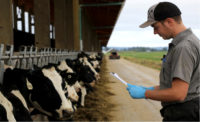A coalition of farmers from throughout the country gathered for a Dairy Together Fly-In to Washington, D.C. Representing key dairy states and a coalition of farm groups under the umbrella of Dairy Together, the participants advocated for dairy policy in the next Farm Bill and shared the Dairy Revitalization Plan with their state delegations and members of the House and Senate Agriculture Committees.
The group included representation from the Farmers Union, Farm Bureau, National Dairy Producers Organization, National Family Farm Coalition and the Organization for Competitive Markets.
The Dairy Revitalization Plan calls for coordinated milk production growth among all dairy producers to stabilize and improve prices. Unlike quota, which is often viewed as overly restrictive, growth management offers a series of incentives to intentionally align milk production growth with demand. The farmer-led plan was developed through a committee process involving members of the Wisconsin Farmers Union (WFU) and Wisconsin Farm Bureau Federation (WFBF), convened by the University of Wisconsin Center for Integrated Agricultural Systems.
Support for the plan has been building and the farmers stressed the need for change in their visits to Capitol Hill. Over the last decade, the USDA recorded the loss of 17,000 dairy farms.
“Something has to change, because we can’t continue down the road we are on, with ongoing farm loss and consolidation of our food supply,” said Westby, Wis., dairy farmer Darin Von Ruden.
The group noted that the research shows that, had growth management been implemented in the 2014 Farm Bill, it would have increased the market milk price by an average of $1.41/cwt between 2014 and 2021 plus paid dividends of $0.72/cwt for farmers choosing not to expand over program allowable amounts. The plan also reduced the degree of variation in prices by 50 percent. It also could have reduced government expenditures on the Dairy Margin Coverage program by $2.6 billion in that time span, while improving net income on farms of all farm sizes that stayed within allowable growth.
“As farmers, we need to realize that there are so few of us, we can’t take the risk of being divided,” said Jack Herricks, who runs a 600-cow dairy with his family and is president of the Monroe County Farm Bureau. He advocated shoulder-to-shoulder with Farmers Union members, in a show of unity. “My grandson asked me recently 'Grandpa, do you think the farm is still gonna be in business when I want to farm?' We're survivors, but, honestly, I don't know how much more farmers can take."
The group noted that the research shows that, had growth management been implemented in the 2014 Farm Bill, it would have increased the market milk price by an average of $1.41/cwt between 2014 and 2021 plus paid dividends of $0.72/cwt for farmers choosing not to expand over program allowable amounts. The plan also reduced the degree of variation in prices by 50 percent. It also could have reduced government expenditures on the Dairy Margin Coverage program by $2.6 billion in that time span, while improving net income on farms of all farm sizes that stayed within allowable growth.
Cambridge, Wis., dairy farmers Tina and Duane Hinchley highlighted the need to stabilize dairy prices so there is a future for the next generation. They recently invested in robotic milkers on the farm and are transitioning the operation to include their daughter, Anna, but it has been a struggle amidst volatile markets and unpredictable prices.
“Everybody else is asking for a minimum living wage. It’s time farmers ask for one,” Tina Hinchley said.
The group stressed it is also a matter of food security.
“We’ve already seen what happens when consolidation hits our agricultural system; we saw it in poultry and in hogs,” pointed out John Larsen, who joined the fly-in as a representative of the National Dairy Producers Organization and Minnesota Farmers Union. “It works until the day it doesn’t, as we witnessed with supply chain struggles during the pandemic.”
WFU Communications Director Danielle Endvick highlighted the urgency behind the movement, noting that more than 7,500 dairy farms have gone out of business since the 2018 Farm Bill was adopted.
“Few of us out in farm country have been untouched by this crisis,” Endvick said. “Many of us have watched friends and family sell out, and we’ve seen the ripple effects in our communities. We need smart dairy policy in this Farm Bill; we can’t wait another four years.”
Mike Eby, president of the Organization for Competitive Markets, sold his dairy herd six years ago, despite having a son who wanted to go into farming.
“It’s a shame to see multigenerational farms have to make that decision, but I see everyday how many farms are exiting,” Eby said. “If we want a viable industry for the next generation, we need to make some changes, and it’s powerful to see like-minded organizations throwing their weight behind this.”
The fly-in delegation included Paul Adams, Eleva, Wis.; Mike Eby, Gordonville, Pa.; Patty Edelburg, Scandinavia, Wis.; Danielle Endvick, Holcombe, Wis.; Jack Herricks, Cashton, Wis.; Tina and Duane Hinchley, Cambridge, Wis.; John Larsen, Mantorville, Minn.; Sarah Lloyd, Wisconsin Dells, Wis.; Deborah Mills, Lake City, Minn.; Michelle Ramirez-White, Madison, Wis.; Karyn Schauf, Barron, Wis.; Antonio Tovar, Washington, D.C.; Darin Von Ruden, Westby, Wis.; Annie Watson, Whitefield, Maine. A delegation from California also participated in virtual meetings with their representatives.
“What is exciting about Dairy Together is the variety of groups in the room,” National Farmers Union President Rob Larew said. “I’ve been in the milking parlor, in back rooms drafting farm bills, and now in this role with Farmers Union working on the advocacy side, and I can tell you, that unity is key.”


